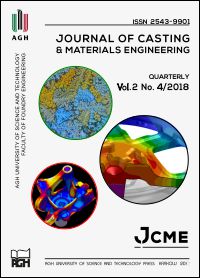Grain-Size Prediction Model in Aluminum Castings Manufactured by Low-Pressure Technology
DOI:
https://doi.org/10.7494/2018.2.4.71Abstract
The grain refinement in a real casting manufactured by Low Pressure Die Casting (LPDC) such as wheels and steering knuckles depends on the grain-refinement potential of the metal and the geometry of the part/process parameters.
For this study, the effect of the cooling rate on the AlSi7Mg alloy with different metal qualities in terms of grain refinement was tested. The grain size has been metallographically evaluated in cylindrical test pieces and in the real wheels and steering knuckles manufactured at the Mapsa and Fagor Ederlan foundries. The Thermolan®-Al system has been used to evaluate the nucleation potential in terms of grain size on a standard cup. The grain size has been modeled taking into account the effect of the cooling rate measured in the center of the cylindrical test parts and the different grain-size potential. Different grades of refinement have been tested. The grain size measured in a real casting (wheel and steering knuckle) was used to calibrate the model for a real part in LPDC for different grain-size potential.
Downloads
References
ASM International (1992). ASM Metals HandBook. Volume 15: Castings. 9th Ed., Materials Park, Ohio, USA.
Gilbert Kaufman J. & Rooy E.L. (2005). Aluminum alloy castings: properties, processes and applications. AFS, ASM International, Materials Park, Ohio, USA.
Gruzleski J.E. & Closset B.M. (1990). The treatment of liquid aluminum-silicon alloys. The American Foundrymen’s Society Inc., Des Plaines, Illinois, USA.
Menk W., Speidel M. & Döpp R. (1992). Die thermische Analyse in der Praxis der Alumiumgiesserei. Giesserei, Zurich: ETH Zürich.
MacKay R.I., Djurdjevic J.H., Sokolowski J.H. & Evans W.J. (2000). Determination of eutectic Si particle modification via a new thermal analysis interpretive method in 319 alloy. AFS Transaction, 108, 511–520.
Jiang J., Sokolowski J.H., Djurdjevic M.B. & Evans W.J. (2000). Recent advances in automated evaluation and on-line prediction of Al-Si eutectic modification level. AFS Transaction, 23, 505–510.
Heusler L., Schneider W., Stolz M., Brieger G. & Hartmann D. (1997). Neuere Untersuchungen zum Einfluss von Phosphor auf die Veredelung von Al-Si-Gusslegierungen mit Natrium oder Strontium. Giesserei-Praxis, 82, 66–76.
Apelian D., Sigworth G.K. & Whaler K.R. (1984). Assessment of grain refinement and modification of Al-Si foundry alloys by thermal analysis. AFS Transaction, 92, 297–307.
Günther B. & Jürgens H. (1984). Automatisierte Durchführung der thermischen Analyse zur Ermittlung des Keimzustandes von Al-Schmelzen und der erzielten Korndroße an Bauteilen aus Aluminium-Guss. Giesserei, 71(24), 928–931.
Niklas A., Abaunza U., Fernández-Calvo A.I., Lacaze J. & Suárez R. (2011). Thermal analysis as a microstructure prediction tool for A356 aluminium parts solidified under various cooling conditions. China Foundry, 8(1), 89–95.
Lacaze J., Ferdian D., Lizarralde I., Niklas A., Eguskiza S. & Fernández-Calvo A.I. (2014). Improved grain size prediction in aluminium-silicon alloys by thermal analysis, 71st World Foundry Congress (WFC 2014): Advanced Sustainable Foundry, 19–21 May 2014, Bilbao, Spain. Curran Associates, Inc., 1216–1222.
Fernández-Calvo A.I., Lizarralde I., Eguskiza S., Santos F. & Niklas A. (2014). Improved Precision in Grain Size Prediction by Thermal Analysis and Statistical Analysis in Aluminium Castings. 71st World Foundry Congress (WFC 2014): Advanced Sustainable Foundry, 19–21 May 2014, Bilbao, Spain. Curran Associates, Inc., 1319–1328.
Lizarralde I., Niklas A., Fernández-Calvo A.I. & Lacaze J. (2013). Effect of the Thermal Modulus and Mould Type on the Grain Size of AlSi7Mg Alloy. In: Sadler B.A. (ed.), Light Metals 2013. The Minerals, Metals & Materials Series. Springer, Cham, 327–331.
Barrenengoa J. (2011). Proyecto Fin de Carrera, Sistema predictivo de la calidad metalúrgica para las aleaciones de fundición de aluminio AlSi7Mg. Escuela Universitaria de Ingeniería Técnica de Minas y Obras Públicas, UPV.
Bekaert F. & Wettinck E. (1996). Study of the grain refinement of A 356 and its control by thermal analysis. Aluminium, 72, 442–447.
Sigworth G.K. & Kuhn T.A. (2007). Grain Refinement of Aluminum Casting Alloys. International Journal of Metalcasting, 1(1), 31–40.
Spittle J.A. (2008). Grain refinement in shape casting of aluminium alloys – Part I. Foundry Trade Journal, 181(3659), 308–314.
Argyropoulos S., Closset B., Gruzleski J.E. & Oger H. (1983). The quantitative control of modification of Al-Si foundry alloys using a thermal analysis technique. AFS Transaction, 91, 350–357.
Ibarra D.C. (1999). Control of grain refinement of Al-Si-alloys by thermal analysis. PhD thesis, McGill University of Montreal, Canada.
Bouchard D. & Kirkaldy J.S. (1997). Prediction of dendrite arm spacing in unsteady and steady state he flow. Metallurgical and Materials Transactions B, 28, 651–663.
Carpentier D. (1994). Modélisation de la formation des microporosités lors de la solidification d´alliages a base d´aluminium. PhD thesis. Institut National Polytechnique de Lorraine, Nancy, France.
Okamoto T. & Kishitake K. (1975). Dendritic structure in uniderectionally solidified aluminum, tin and zinc base binary alloys. Journal of Crystal Growth, 29, 137–146.
Downloads
Published
Issue
Section
How to Cite
Accepted 2019-01-10
Published 2019-01-23


